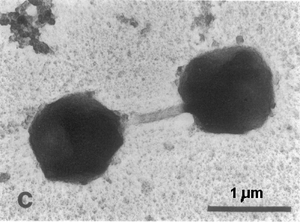Hyperthermus
|
NCBI: |

Classification
Higher order taxa
Archaea; Crenarchaeota; Thermoprotei; Desulfurococcales; Pyrodictiaceae
Species
Hyperthermus butylicus
Description and significance
Hypperthermus is a hyperthermophilic, sulfur reducing archaeon that grows between 95 and 106°C and at pH of 7.0.
Genome structure
The genome of Hyperthermus is currently being sequenced by the group from the University of Copenhagen. The G + C content of the DNA is around 55%.
Cell structure and metabolism
The cells of Hyperthermus are irregular spherical (around 1.5 µm in diameter) shape with edges between partially flattened surfaces. The ones that grow in higher temperature often contain vacuoles within their cytoplasm, sometimes immediately below the S layer. The archaeon utilizes peptide mixtures, obtained by various hydrolysis procedures (eg, Tryptone, Trypticase, Merck peptone from casein, gelatin, and a chymotryptic digest of casein) as carbon and energy sources. No growth has been observed with starch, maltose, sucrose, lactose, glucose, galactose, ribose, lactic acid, lactic acid ethylester, glyoxylate, pyruvate, oxalate, fumarate, maleate, malate, malonate, and formate.
Ecology
The strains of Hyperthermus butylicus were isolated from the sea floor of a hot, solfataric babitat on the coast of São Miguel Island in Azores, Portugal. With its ability to live at the temperature of 106°C, it is one of the most thermophilic archaea isolated so far. Also, interestingly, despite its being found in a marine environment,
